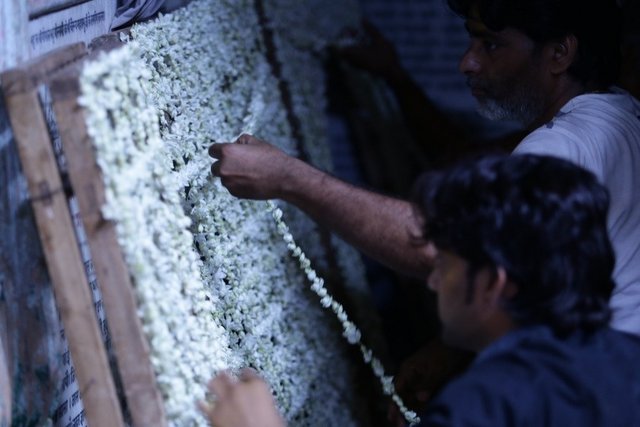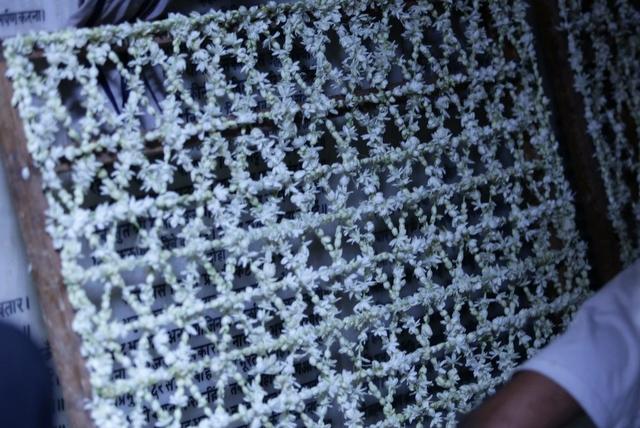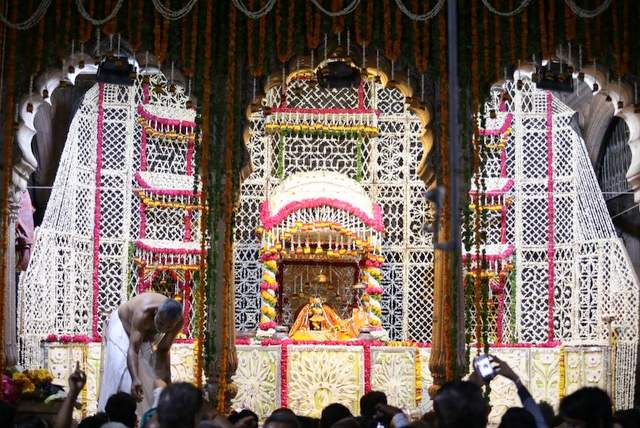
Since the beginning of human consciousness, man has been worshiping Nature in its various forms. Humankind in its imagination manifested many forms of Nature. And found bliss in expressing his gratitude towards nature. As times passed, Man used the commodities available from nature to worship the divine form of God. This was directly or indirectly linked with the flora and fauna. Phool Bangla is one such celebration of nature.

In India, almost everything available from nature has been regarded as the most pious offering to God. The flowers are special and important offerings. As Lord Krishna says in Srimad Bhagwad Gita:
Patram Pushpam Falam Toyam Yo Mai Bhaktya Prayachhati
Tadaham Bhaktyupahrirtmashnami Prayatatmanah
O Arjuna! Whether a Bhakta offers me a leaf, a flower, a fruit, or even a small amount of water with Bhakti-Bhava, I accept everything with affection.
All the ancient texts including Vedas, Upanishads, Puranas, etc. have depicted the utmost importance of nature and its worship in various forms. Braj has been a very important place in this very setting. The whole of Krishna Leela was nature-centric in some way or the other. Govardhan, Yamuna, Vrinda, Gau, etc. are representative of nature playing an important role in Lord Krishna’s life.
History of Phool Bangla Tradition

In 16th CE during the Bhakti movement, with the arrival of various saints from all over the country, Braj became instrumental in reestablishing the Krishna Bhava again in the then existing political and social condition. These saints wholeheartedly accepted nature’s abundance of Braj in the form of groves. They made the surrounding nature an important part of their daily rituals known as Seva.
Various sects started by their spiritual leaders some way or the other tried to incorporate nature in their ways of worship. This led to the development of many temples around the holy land of Braj. Further, it led to the nurturing of various traditional and cultural art forms that were used for the Seva of the divine. Seva led to the development of many cultural crafts and art forms like a chariot in Ratha Yatra, swings for Jhoolan Yatra. The floral decoration is better known as Phool Bangla for the temples.
Dhanam Vrindavanam Tena Bhakti Nrityati Yatra Cha
Blessed is the divine land of Vrindavan where Bhakti dances in full ecstasy.
The dance of Bhakti in Vrindavan denotes the highest epitome of bliss. It was the result of diverse worship rituals introduced by the spiritual personalities of that era. That is what we see in many cultural crafts in today’s times in the land of Braj.
Phool Bangla in Vrindavan
The present-day tradition of Vrindavan is a continuation of the same age-old ritualistic tradition. It is made and celebrated all over the Braj. Though, it has a special reverence in Vrindavan due to diversity in the tradition present here.
In 16th CE texts we find words like Phool Mahal, Phool Kunj, Phool Bhawan, Phool Baithak. Finally, the word Phool Bangla appears in the 17th CE texts. Medieval texts like Haribhakivilas, Kelimal, Hit Chaturasi, Sursagar, etc. talk extensively about the Phool Bangla as a form of Seva.
As per our ancient texts, the flower decoration is one of the 64 Kala or 64 art forms that humans can learn. Human sentiments along with the rituals present a beautiful aura in Braj. The attempt to recreate the natural setting of the divine forests of Braj in the scorching summer is to provide the coolness of beautiful flowers for the comfort of Vigrahas in the temple. That is the core principle of the making of these floral decorations.
When does this take place?
These festivities happen from Chaitra Shukla Ekadashi or Akshay Tritiya till a day before Hariyali Teej. That is for a period of three months Vaishakh, Jyestha, and Aashadh. Calendar wise it is mid-April to mid-July.
Summers are the best time to witness the floral festivities due to the high availability of flowers. As the monsoon starts there is a decline in the size of floral decorations. That is because the flowers become scarce to carry out such large decorations in the temple.
Bela or Jasmine is an abundantly used flower in these decorations. Roses, Marigold, and Ashoka leaf are also used in plenty. Even Banana bark is also used for various decorations in the floral decorations. The diversity of flowers mentioned in various religious sects of Vrindavan plays an important part in the implementation of this art form from 16th CE to present times. Mostly all the temples in Vrindavan follow this tradition. Some of the famous temples that follow these traditions are Bankey Bihari Ji, Radhavallabh Ji, Radharaman Ji, RadhaDamodar Ji, Rang Ji, RadhashyamSundar Ji, Bhatta Ji, etc.

How does it look like?
Phool Bangla is nothing but the systematic arrangement of various wooden frames known as Thaat in the local language. They are used to create a temporary temple structure. The Vigraha’s or Murtis are placed in these floral temples in the evening and remain there till night.
These frames have different names such as Chajja, Pichwai, Haathi, Bagli, etc. They are placed according to the designs. The artist covers the frames in various patterns with the long thin garlands of Bela over the thin iron nails arranged along the border of the frame. These arrangements of frames are being done according to the shape and size of Jagamohan, the immediate space outside the Garbhagriha where the deity is placed.




Banana Bark Decoration
For the Banana bark decoration, the layers of the innermost core of Banana plant barks are removed carefully. They are then placed artistically over the frames. It takes around 4 to 6 hours for a team of 6 to 10 people to complete a large size floral decoration. At present, there are about 6 to 7 groups of people who are trained in making these traditional decorations in Vrindavan. And various other temples outside Vrindavan, in other parts of Braj.
A famous 18th CE Braj-Bhasha couplet from Shri Premdas Ji describing the beauty of this tradition:-
Motiya Ki Jaali Mai Gulab Hi Ke Fool Khanchey, Bangla Mai Rache Sonjuhi Ke Se Dwar Hai
Kanj Ke Kamal Raaje Madhavi Ke Chajja Chaanje, Peet Chameli Ke Latkan Ati Charu Hai
Phool Ke Singhasan Pai Phool Rahe Shyama Shyam, Phoolan Ke Abhiram Shobhit Shringar Hai
Premdas Hit Vaari Phooli Ati Phoolwari, Kunj Keli Phooli Bhaari Phoole Ratimaar Hai

Land of Festivities
Vrindavan is the land of festivities. There is hardly any day where we don’t have any celebration taking place. There is a saying in Bhakti tradition in Braj i.e. Bhava-Grahi Janardanah. That means that Lord Krishna accepts everything submitted to him with Bhava. Vrindavan is the epitome of bhakti. The ritualistic aspect here is filled with the feeling of comforting the divine according to the weather conditions, that fills the heart of a Bhakta.
Aanukulyen Shri Krishnanushilnam Sa Bhakti Uttama
When a Seva is performed for the comfort of Krishna that act of Seva is the highest stage of Bhakti. Vrindavan has been the land of Seva. This act of service is seen everywhere in every corner for ages now. Seva is an immortal part of the ritualistic aspect of Vrindavan. So is it a catalyst in making the various cultural forms associated with temples. A beautiful epitome of the relationship between Bhakta and Bhagwan.
All the photographs in this post unless credited belong to Nishant Sharma Photography. Special Thanks to him for these beautiful photographs!!!
Radhe-Radhe !!!
This is a guest post by Sushant Bharti.
Sushant Bharti is a Conservation Architect. He graduated from the School of Planning & Architecture, New Delhi with a Bachelor’s degree in architecture from Vastukala Academy College of Architecture. He has a keen interest in understanding the cultural aspect of India. Along with architectural diversity, his main area of research is around the ‘Cultural Heritage of Braj’ and ‘Indian Temple Architecture’. Currently, he is working as a Research Assistant at the National Museum Institute, National Museum, Janpath, New Delhi.
Read Sushant’s post on RasikPriya – The Geet Govind of Bundelkhand
The post Phool Bangla Tradition Of Braj: In The Light Of Vrindavan appeared first on Inditales.
